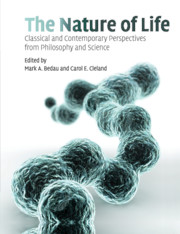Book contents
- Frontmatter
- Contents
- Preface
- Acknowledgments
- Sources
- About the authors
- Introduction
- SECTION I CLASSICAL DISCUSSIONS OF LIFE
- SECTION II THE ORIGIN AND EXTENT OF NATURAL LIFE
- SECTION III ARTIFICIAL LIFE AND SYNTHETIC BIOLOGY
- SECTION IV DEFINING AND EXPLAINING LIFE
- Supplementary bibliography on life
- Index
- References
SECTION IV - DEFINING AND EXPLAINING LIFE
Published online by Cambridge University Press: 10 November 2010
- Frontmatter
- Contents
- Preface
- Acknowledgments
- Sources
- About the authors
- Introduction
- SECTION I CLASSICAL DISCUSSIONS OF LIFE
- SECTION II THE ORIGIN AND EXTENT OF NATURAL LIFE
- SECTION III ARTIFICIAL LIFE AND SYNTHETIC BIOLOGY
- SECTION IV DEFINING AND EXPLAINING LIFE
- Supplementary bibliography on life
- Index
- References
Summary
The chapters in this section focus on the big question: What is life? This question cannot be answered by providing a list of things that are or were once alive. It is concerned with the very nature of life, with what qualifies something as a living thing; life in this sense is not contrasted with death but rather with nonlife. This section contains a diverse collection of views, but the authors all share the conviction that there is something special and fundamental about living systems, and hence that a general, unified explanation of life is in order. Not everyone shares this view. As the chapters in Section III by Sober and Keller illustrate, some researchers are skeptical about the wisdom of formulating general theories of life.
Running through this section is a disagreement over whether the stuff that composes life is essential to it. Some authors simply assume that this is the case, although they might also emphasize the importance of the way in which it is structured (spatially arranged). Others explicate life in terms of abstract organizational or functional properties that are independent of the material out of which it is composed. How one decides this issue has critical consequences for the possibility of strong artificial life (see Section III) as well as the possibilities of truly alien forms of natural life (see Section II).
- Type
- Chapter
- Information
- The Nature of LifeClassical and Contemporary Perspectives from Philosophy and Science, pp. 295 - 302Publisher: Cambridge University PressPrint publication year: 2010



